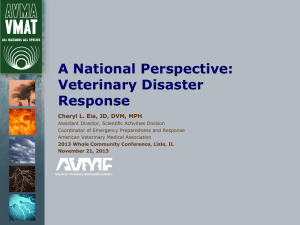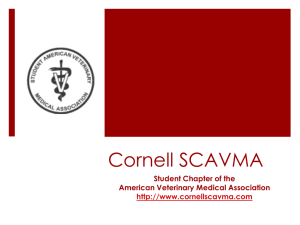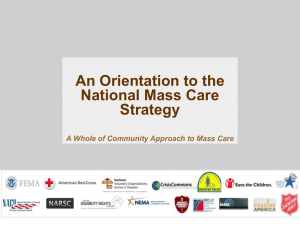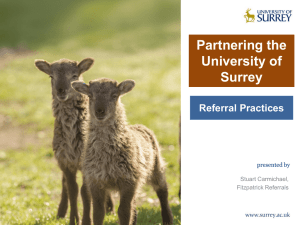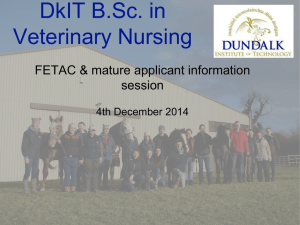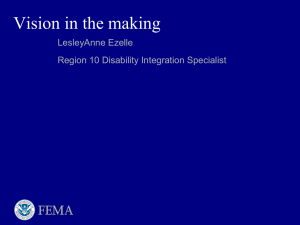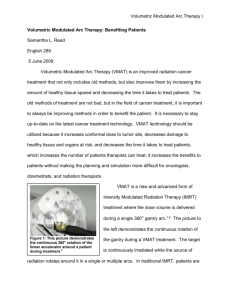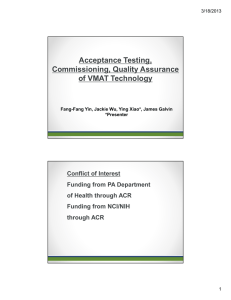How the Pros Handle Disasters and What You Need to Know
advertisement
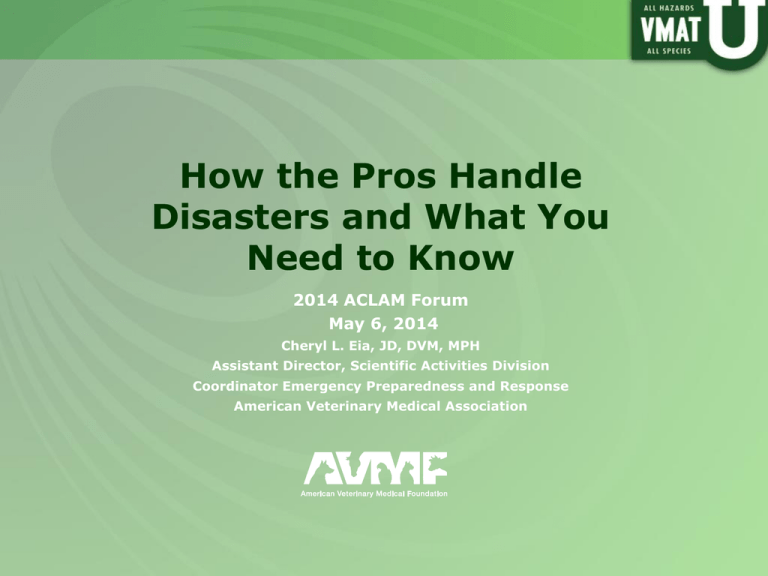
How the Pros Handle Disasters and What You Need to Know 2014 ACLAM Forum May 6, 2014 Cheryl L. Eia, JD, DVM, MPH Assistant Director, Scientific Activities Division Coordinator Emergency Preparedness and Response American Veterinary Medical Association Disasters FEMA: A Pillot USGS FEMA: P. Lynch NOAA More Disasters FEMA: B. Bahler FEMA Newa FEMA: M Reiger Today’s Presentation Overview of disaster preparedness and response Local State Federal All Disasters Begin and End Locally All Disasters are Local Image: A. Kingsbury, ISU, CFSPH Organization of US Disaster Response National Incident Management System (NIMS) Focus: preparedness, communication, resource management, incident command, incident management National Response Framework Unified national response Uses NIMS 15 Emergency Support Function Annexes Lead agency designated Illustration: A. Kingsbury, CFSPH, Iowa State University ESFs in Animal Issues ESF #6- Mass Care, Emergency Assistance, Housing and Human Services (FEMA) ESF #8- Public Health and Medical Services (HHS) ESF# 9- Search and Rescue (FEMA) ESF #11- Agriculture and Natural Resources (USDA, DOI) ESF #14- Long-Term Community Recovery (FEMA) Incident Command System (ICS) Standardized on-scene organizational structure Standardized terminology Enables response to be coordinated among multiple personnel and agencies Can expand or contract as needed by size of incident ICS Training FEMA Emergency Management Institute http://training.fema.gov/is/ IS 100: Intro to ICS IS 200: ICS for Single Resources and Initial Action Incidents IS 700: National Incident Management System (NIMS) IS 800: National Response Framework Incident Command System (ICS) Command Safety Information Liaison Operations Plans Logistics Admin / Finance Illustration: CFSPH, Iowa State University All Disasters are Local Image: A. Kingsbury, ISU, CFSPH Local Authorities Responsibilities defined by statute Emergency manager works with local agencies and organizations Local agencies include: Animal control/law enforcement Zoning/code enforcement Public health agencies Emergency management agencies Animals in the Community Pets Service Animals Livestock More Animals Biomedical research Zoos, aquariums Wildlife sanctuaries Kennels Veterinary hospitals Wildlife in surrounding areas Local Stakeholders Emergency Management Agency Public Health Agency Environmental Health Agency Human Services/Housing authority University and/or Cooperative Extension Law Enforcement/Fire/EMS Animal Control/Animal Shelter Local Veterinary Medical Assn/Practitioners Local Livestock Industry Assn Voluntary Organizations Local chapters: Red Cross, VOAD Citizen Corps Council Medical Corps Reserve Units Private Foundations Kennels and Animal Service Enterprises Animal feed and retail enterprises Concerned Citizens Laboratory animal facilities Source: Animal Emergency Management Road Map: NASAAEP Preparedness and Resource Management Best Practices Working Group. Local Resources Local veterinarians/VMAs Local animal control CARTs Citizen Corps MRCs Local NGOs All Disasters are Local Image: A. Kingsbury, ISU, CFSPH State and Tribal Authorities Governor’s Office of Emergency Management State Emergency Operations Plan (EOP) Responsible agency varies with state: Emergency Management Homeland Security State Agencies in Emergency Response State State State State State Department of Agriculture Animal Health Official (State Vet) Department of Homeland Security Emergency Management Agency Public Health Agency State Resources State Agencies Dept. Agriculture Emergency Management State Animal Health Official Other Resources SART VMRC Resources from other states (EMAC) NGOs State VMA Other state organizations AVMA VMAT AVMA VMAT American Veterinary Medical Association Mission: Improving Animal and Human Health, Advancing the Veterinary Medical Profession Over 85,000 members Volunteer-driven 600 volunteers: 7 Councils, 25 Committees Committee on Disaster and Emergency Issues 11/01 EB Develop AVMA position statements on disaster and emergency issues affecting the veterinary profession; Develop guidelines for the veterinary profession VMAT oversight VMAT History Hurricane Andrew:1992 Category 5 storm Affected large numbers of animals Damage to veterinary infrastructure VMAT Created 1993: MOU with the United States Public Health Service 1994: MOU with the USDA/APHIS 2008 Law changes Two separate organizations AVMA VMAT DHHS NVRT Continued collaboration and communication VMAT Deployments Hurricane Floyd 1999 World Trade Center 2001 State of the Union Address 2002, 2003, 2004 Winter Olympics 2002 President Reagan’s Funeral 2004 Hurricanes 2005 Superstorm Sandy 2012 VMAT at 10 year commemoration of 9/11 attacks VMAT’s Role VMAT Image: A. Kingsbury, ISU, CFSPH VMAT: Organization Volunteers Four teams Regionally located Each team: 6 person unit on call Deploy on state request Veterinarians, veterinary technicians and other specialists VMAT’s Roles Early Assessment Basic Treatment Training VMAT U Cost Travel, housing and per diem expenses are covered by the Requirements Signed MOU is absolutely necessary avma.org/vmat @AVMAVMAT Partnerships in Planning and Response USDA/APHIS/AC DHS/FEMA HHS NASAAEP Regional Alliances – MSP, SAADRA, MAAEMA NARSC AVMA & VMAT SARTS/CARTS Local NGOs National Alliance of State Animal and Agricultural Emergency Programs (NASAAEP) Association of State-level programs Membership Regulatory agencies (Agriculture, Public Health) Emergency Management SART & VMRC-type programs Forum for communication, informationsharing and consensus among states Best practices library www.nasaaep.org National Animal Rescue & Sheltering Coalition (NARSC) American Humane Association (AHA) American Society for the Prevention of Cruelty to Animals (ASPCA) Best Friends Animal Society Code 3 Associates International Fund for Animal Welfare (IFAW) National Animal Control Association (NACA) Society of Animal Welfare Administrators (SAWA) Red Rover American Red Cross NASAAEP Petfinder.org Foundation Pet Smart Charities AVMA AVMF www.narsc.net All Disasters are Local Image: A. Kingsbury, ISU, CFSPH Federal Response Request from Governor for a Presidential declaration Allows use of federal resources May also allow for FEMA public assistance funds Federal Veterinary Resources National Veterinary Response Teams (NVRT) HHS ESF 8 – Public Health and Medical Services http://www.phe.gov/Preparedness/responders/ndms/teams/Pa ges/nvrt.aspx Federal Veterinary Resources National Animal Health Emergency Response Corps (NAHERC) USDA ESF 11 http://www.aphis.usda.gov/wps/portal/aphis/ourfocus/animalh ealth/sa_vet_accreditation?1dmy&urile=wcm%3apath%3a/aph is_content_library/sa_our_focus/sa_animal_health/sa_emergen cy_management/ct_naherc Thank You!! Questions? Dr. Cheryl Eia 800-248-2862 ext. 6633 ceia@avma.org
